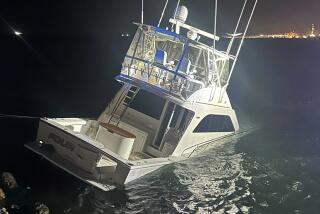Waterproof Warnings
- Share via
Before Frank Jennings’ boys were in kindergarten, they knew how to call in a mayday from the boat’s radio. They had been taught about all aspects of their dad’s boat, including where all the emergency gear was stored.
Jennings, a U.S. Coast Guard chief petty officer, wasn’t being overcautious. He’d seen too many boating disasters that could have been avoided by simple safety measures, including instances in which young children had saved their parents by using the radio. “Show your kids that operating a boat is serious business,” Jennings said. “Have fun, but pay attention at all times.”
With 75 million Americans expected to take to the water this summer in all kinds of boats--10% more than last season--a few basic safety lessons are in order.
Start by insisting that the children wear life jackets. Just having them in the boat--or canoe or kayak--isn’t good enough, according to the experts.
“It’s like having a seat belt in the car and not wearing it. It won’t do you any good,” said David Pilvelait, spokesman for the BOAT/U.S. Foundation, the nation’s largest organization of recreational boaters. They aren’t expensive; many cost less than $20.
If the kids balk at wearing them, insisting they aren’t cool or that they don’t need them, tell them that 80% of the people who die each year in boating accidents drown because they weren’t wearing life jackets. You might want to add that members of the Coast Guard always wear them in moving boats, according to Jennings.
A growing number of states have passed laws requiring children to wear them in moving boats. “Major injuries can happen in the blink of an eye,” said Heather Paul, director of the nonprofit National Safe Kids Campaign. “Something that takes just a few seconds [can cause] lifelong sadness.”
“A life vest will keep a child afloat until someone can fish him out,” Jennings said. It can also keep an unconscious person’s head above water. And because the life vests are bright colors, they make a child--or adult--easier to spot in the water.
Parents and kids who plan to be boating this summer would do well to take a low-cost safety course. (Call 800-336-BOAT to find a course approved by the Coast Guard. There are about 18,000 offered around the country.)
“We tell the kids if they get some formal instruction, they’ll have a lot more fun,” said Jay Crihfield, who directs the Aquatics Camp in Evanston, Ill., where about 350 youngsters learn boating basics each season.
“Kids always overestimate their ability and underestimate the conditions,” said Crihfield, who has been sailing since he was 10.
Here are some other tips whether you plan to sail, canoe or just do a little fishing in a motorboat:
* Teach the kids to stay with the boat if it capsizes. “Don’t try to swim to shore,” Jennings said. Advise them to get on top of the boat, where it will be a little warmer than in the water.
* Always get a weather forecast before sailing. Change your plans if the water is too rough or a storm is approaching.
* If the kids are heading out alone, make sure they stay within sight of shore, and keep your eyes on them.
“That’s not the time for parents to disappear,” Jennings said. “I would never turn my back if the kids were out in a boat.”
That’s also true if the children are hitting the beach, lifeguards advise. “We get 200 lost kids a week just at our beach,” said Bill Richardson, retired Huntington Beach marine safety captain and president of the 8,000-member U.S. Lifesaving Assn.
Richardson’s biggest concern is children and adults who swim in areas that aren’t guarded.
Just as boaters need to check conditions before heading out, Richardson said kids must be taught to ask lifeguards about the always-changing water conditions when they first arrive at the beach.
“There are different hazards at different beaches,” he said. “The best way to get that information is from the lifeguards,” he said.
“Lifeguards worry most about the 8-to-10-year-old set on the beach. They’re risk-takers,” he said, “and they’re more likely to get into trouble.”
To prevent that from happening, the Lifesaving Assn. encourages youngsters to take part in the Junior Lifeguard programs across the country. (Write the U.S. Lifesaving Assn., P.O. Box 366, Huntington Beach, CA 92648, for information about local programs.)
Taking the Kids appears weekly.
More to Read
Sign up for Essential California
The most important California stories and recommendations in your inbox every morning.
You may occasionally receive promotional content from the Los Angeles Times.













